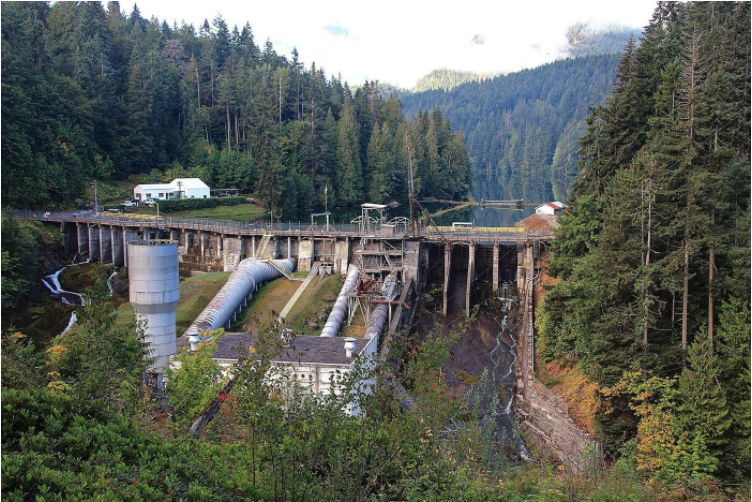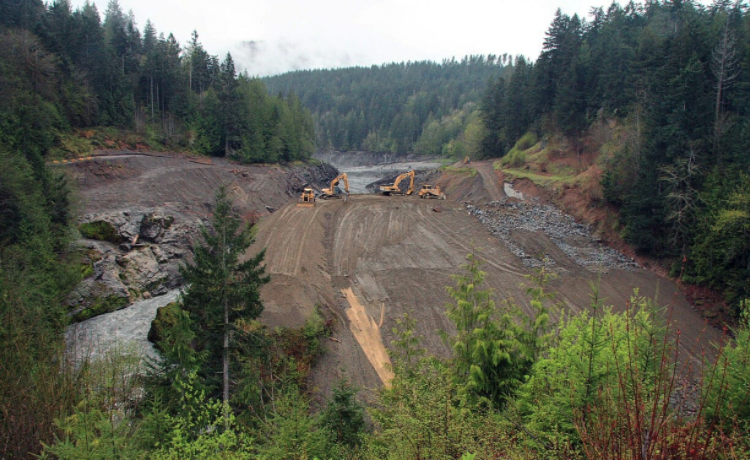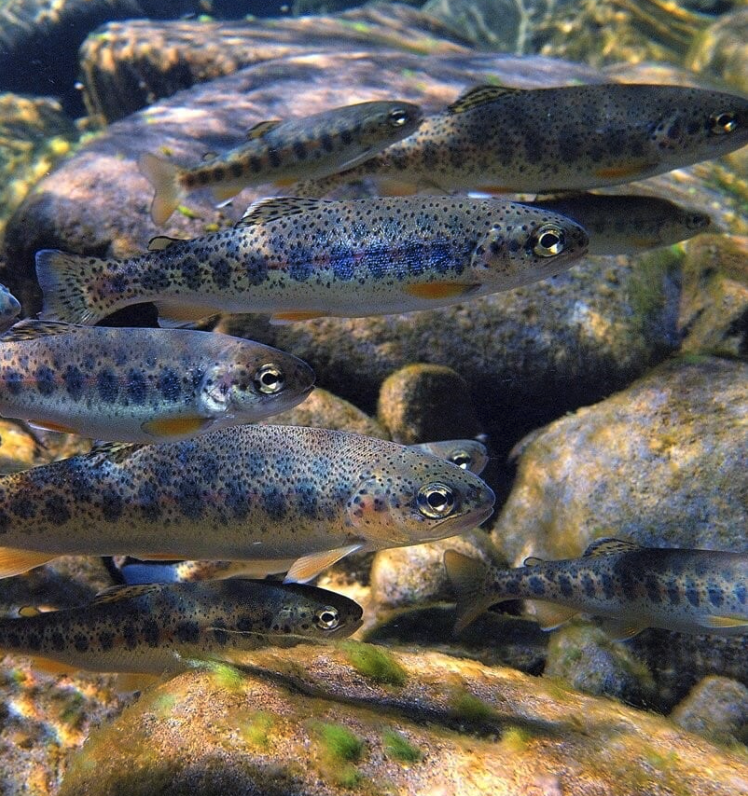Summer steelhead in the Elwha rise from the ashes
By John McMillan
Should we invest in dam removal?
It’s a question that many communities, businesses and policy-makers are facing these days — partly because of aging infrastructure and financial liabilities, and partly because of legal obligations to protect water quality and recover declining salmon and steelhead populations.
To that, I say:
“Let the fish tell us what works.”
One place where steelhead have surprised scientists about the potential for dam removal is the Elwha River, on the northwestern tip of Washington’s Olympic Peninsula. This is a river that grew 100-pound Chinooks and prolific wild steelhead runs before their migrations were blocked over a century ago by two dams.
Those two dams basically killed this magnificent river.

Elwha Dam, prior to removal.
However, in 1992 Congress passed the Elwha River Ecosystem and Fisheries Restoration Act, authorizing removal of the two dams to restore this fish-starved ecosystem. After two decades of planning, the largest dam removal in U.S. history began in September, 2011. Six months later Elwha Dam (the lower of the two) was gone, followed by the Glines Canyon Dam in 2014.
I live two miles from the mouth of the Elwha, four miles from where the Elwha Dam once stood and about thirteen miles from the old Glines Canyon dam. I have spent many hours over the past decade working as a small part of a large team of partners (including scientists Lower Elwha Tribe, NMFS/NWFSC, Olympic National Park, USFWS, WDFW, USGS, USBR, and others) monitoring salmonids in this watershed. It has become my home river, and while it is closed to angling until populations have sufficiently rebuilt, I walk or snorkel the river at least once a week – both professionally and on my free time. There is so much to see, and for a scientist, so much to learn.
I don’t pay equal attention to all the fish in this river. Each species is unique, but I am most interested in steelhead.
The Elwha River once supported robust summer and winter steelhead runs. But the two dams blocked their upstream migration and basically put an end to that. By the time I started working on the Elwha in 2009, both populations had greatly declined and all that remained was a small population of wild steelhead, all of which were winter runs.

Removing Elwha Dam, 2011.
Surveys I participated in with the Lower Elwha Tribe and NMFS/NWFSC suggested a total winter run population size of less than 300 fish. They hung by a thread in the five miles of habitat that remained below the lower dam.
At that time, little was known about summer steelhead in the Elwha. Historically, scientists knew they were present. There are photos of the fish, and stories of anglers coming to the Elwha to catch summer runs. Still, I and others conducted numerous snorkel surveys in the lower Elwha from 2009 through 2012, when dam removal began, and only counted a total of three summer steelhead that entire time.
Lots of snorkel surveys, very few fish. And for those that we did observe, it was impossible to know whether those fish were native to the river or strays from other populations.
For all intents and purposes, wild summer steelhead were extinct in the Elwha.
Today, with the two dams gone and the river well on its way to functioning more naturally, what has become of the steelhead? What are the fish telling us about dam removal?
First, the winter runs are improving, exceeding 1,000 fish in the best year so far. The winter runs are a mix of wild and hatchery fish, with at least half the fish likely of hatchery origin. Scientists are using DNA and other methods to help monitor the winter steelhead in different streams and locations. Those results are not yet complete, so much remains to be learned about which winter steelhead are doing what and where in the Elwha.
Regardless, the population of winter run steelhead in the Elwha has increased, and each year their distribution seems to extend a little further upstream.
Second, snorkel surveys by Olympic National Park last September indicated upwards of 70 adult summer steelhead in the upper Elwha. And those surveys were a conservative estimate. They did not survey all the habitat. Still, from extinct to present in measurable quantities within five years is not a bad start. The Elwha’s summer steelhead, which are not supplemented by a hatchery, have – almost literally – risen from the ashes like the Phoenix.
Third, there are very high densities of juvenile steelhead in several tributary creeks and the sections of the mainstem Elwha that meander across the old lake beds. These fish are also large and fat, and their increase supports a concomitant boom in steelhead smolts. Things are looking good for the juveniles.

Juvenile O. mykiss, Elwha River (John McMillan)
Among all of these findings, the return of summer steelhead to the Elwha is the most shocking. I don’t think any scientist could have envisioned what is actually happening, at least not this quickly.
This summer, Olympic National Park scientists Sam Brenkman and Pat Crain worked with other agencies and scientists to conduct a riverscape survey of the Elwha, which consists of using teams of snorkelers to survey the mainstem Elwha from headwaters to the ocean. The only section not surveyed was Grand Canyon, which is nearly impossible to study in this way because of its rapids and boulders (which makes it an ideal place for summer steelhead — more on that later).
It’s fun, but tough work. Consecutive days of snorkeling miles of river, in cold water and remote locations. Do it for four to five straight days and it wears on even the toughest person. Kudos to them.
The surveyors counted 216 summer steelhead, nearly all of which were unclipped and presumed to be wild. That may not seem like a lot of fish, but keep in mind populations of wild summer runs are often fairly small in rivers that drain the Coast Range compared to those that drain the Cascades. And, the actual number is likely quite a bit higher as the 216 figure did not account for fish that surveyors missed.
Research by Thomas Buehrens and Dan Rawding, where they conducted snorkel surveys with a known number of fish marked with visible tags, suggests that experienced snorkelers count about 20 to 60 percent of the total fish. In other words, the estimate of 216 wild summer steelhead could be 40 to 80 percent higher. Adult steelhead are hard to count — even the best divers miss fish (I can attest to that myself). Regardless of how many fish are not counted when snorkeling, the point is that the actual count is likely higher.
Lastly, the count also doesn’t include steelhead that were in Grand Canyon, which is a likely holding place for summer steelhead.
Considering those factors, it is presumable that summer steelhead in the Elwha River are now as or more abundant than populations of summer steelhead in the Quillayute, Hoh, and Queets River basins that are also located on the Olympic Peninsula. Think about that for a second. From zero to well over 200 fish in four years.
Remarkable. Lamborghini would be jealous.
Of course, summer steelhead are not the only fish success story on the Elwha. Bull trout are also doing well here and you can read about them and other species in this recent article.

John McMillan with a fine winter steelhead (not from the Elwha).
Where are all the summer steelhead now recolonizing the Elwha coming from? Great question. We don’t yet know. Here are some guesses.
Some are likely strays from adjacent populations, but it’s unlikely they all are because there are not any nearby populations that are abundant enough to have that many fish drift away and still remain viable.
It’s also possible that the fish are derived from the resident rainbow trout sequestered above the dams for 100 years. These O. mykiss don’t lose their ability to migrate to the ocean, even if they persist in resident form for multiple generations. Which means this “reawakening” of summer runs in the Elwha may be fostered by their resident cohorts.
Ultimately, DNA and scales will help determine where the fish came from. Until then, I can only enjoy the ecological play that is unfolding in my backyard. And listen to the steelhead’s answer: dam removal is working.
John McMillan is a leading steelhead scientist and lifelong steelhead angler. He is the science director for TU’s Wild Steelhead Initiative. This article was first published on the Wild Steelheaders United blog.


